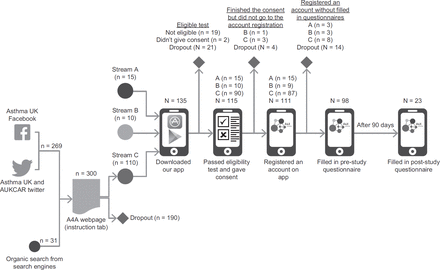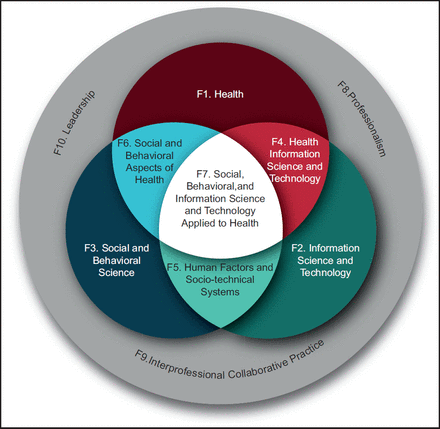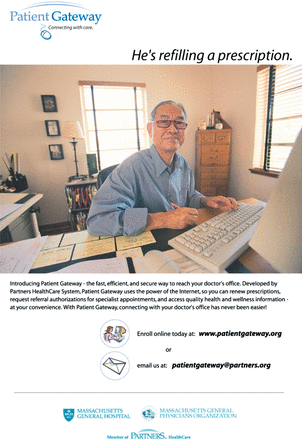Abstract
Background Apps can potentially support asthma self-management; however, attracting downloads and encouraging on-going adherence are challenging.
Objectives We observed the impact of different recruitment strategies and app features on adoption and continued use.
Methods Practice nurses in five practices in Lothian/Oxford approached adults with active asthma to try out a prototype app. We also advertised the app via social media (Asthma UK; AUK Centre for Applied Research). We observed patients’ download and retention rates and sent pre- and post-trial questionnaires. We sampled 15 patients for interviews before and after using our app for 1 month to explore motivations, triggers and barriers to adoption and usage. Interviews were transcribed and analysed thematically with reference to the Fogg behaviour model.
Results Social media attracted 87 users, but only 15 (17%) used the app for 30 days. Practices recruited 24 patients, 13 (54%) continued for 30 days. Successful adoption was dependent on ease of downloading and sufficient motivation. Some patients needed technological assistance with downloading the app and starting to use the features. Adherence was dependent on motivation derived from a sense that the healthcare professional and/or researcher was interested in the results, and that using an app to support their self-management could improve their asthma control.
Conclusion Social media attracted more downloads in a short time. However, most patients stopped using the app within a month. Practices attracted fewer downloads, but patents adhered longer to the app. Dual promotion strategies (social media with practice support) may be the optimal approach to encourage adoption and adherence to telehealth.
INTRODUCTION
Asthma is one of the most common long term conditions, affecting over 235 million people worldwide.1 It can be controlled by medications, but is ideally managed in the context of supported self-management, with an asthma action plan provided by clinicians explaining what to do when symptoms are worsening. However, few asthma patients have an asthma action plan2 despite overwhelming evidence that supported self-management improves asthma outcomes.3 Asthma action plans are usually paper-based but are easily mislaid. One solution is to incorporate them within a mobile app to facilitate availability when it is needed.
Adoption in relation to apps refers to the process of persuading – or triggering – someone to download an app. Adherence refers to the sustained use of an app, not necessarily every day but when needed. The Fogg behaviour model suggests that three core elements motivation, ability and a trigger must converge at the same time for a desired behaviour to take place.4 Motivation and ability can be traded off against one another, for example, patients may be willing to perform a difficult task if they are highly motivated by the promise of better health outcomes. Ability refers to the patients’ skill/dexterity with respect to downloading and using the app, which in turn, is related to the simplicity (or otherwise) of using the app. A trigger is a stimulus that prompts patients to adopt and use the app (e.g. an acute attack, an advertisement or clinician’s suggestion).
If app use is to contribute to supported self-management, it is important to understand how to increase motivation to use it, ensure the app is within patients’ ability to use and the impact of different types of trigger. To explore these challenges, we therefore developed a prototype app to support asthma self-management. We then observed the impact of different recruitment strategies on adoption and explored features associated with adoption and adherence to app usage.
METHODS
This study commenced in September 2016 and ended in July 2017, with the approval of the South East Scotland National Health Service Research Ethics Committees (NHS REC 02) and the National Health Service Health Research Authority (NHS HRA). The REC reference number was 16/SS/0101. All participants gave their fully informed consent.
Settings
Adults requiring medication to manage their asthma were approached to participate in this study via their primary care practice or via social media.
Primary care practice
Five UK primary care practices (four in Lothian; one in Oxford), each of which had at least one nurse who provided asthma care, participated in the study. At a training session, the nurses were provided with packs, including a practical guide on inviting patients to download and use the app, a log to record the gender and age of the patients to whom they gave information packs and contact details of the research team for queries.
Social media
The Facebook and Twitter platforms of Asthma UK and the Asthma UK Centre for Applied Research (AUKCAR) promoted the study. The messages included brief information and a link to information for patients on how to download the app (e.g. would you like to test an app that helps you manage your asthma better? [shortened URL], Need a helping hand to manage your asthma? Try our new app [shortened URL]). Asthma UK had 379,000 followers in Twitter5 and 66,665 followers in Facebook in August 20176; while the AUKCAR had 577 followers in Twitter7 in August 2017 (but no Facebook account).
App prototype
Based on our previous systematic review,8 a review of social forum discussions about the ‘wanted’ features of an asthma app9 and the advice of our lay and professional advisory groups, we developed a prototype app. With this app, patients could monitor (on a five-point scale) 10 aspects of their asthma status, including the Royal College of Physicians three-questions,10 use of reliever inhaler, use of preventer inhaler, nasal symptoms, smoking status and exercise level. Other features in the app included a current medication record, medication and task reminders, peak flow log, a free-text diary and a health report (that could be e-mailed to their practices). There was also an app tutorial and a facility to ask questions about the app. In addition, the app incorporated a blank asthma action plan, based on the Asthma UK action plan.11 Patients were advised that their general practitioner or asthma nurse could help to complete the action plan during their next review.
Patient recruitment
To explore the impact of different recruitment strategies on adoption of the app, we utilised three different approaches to invite patients to use the app for up to 3 months:
-
Practice recruitment: Practices used two strategies to recruit participants. Each practice invited people on their asthma register (randomly selecting 100 people in larger practices) by a letter to use the app and participate in the qualitative aspects of the research (Stream A). In addition, practice asthma nurses invited patients to try out the app by handing out information packs to patients who attended for a routine consultation during the course of the study by Stream B. Nurses were not expected to teach patients to download and use the app; technological support was provided by the research team and the app developer.
-
Social Media recruitment: Users of the Facebook and Twitter platforms of Asthma UK and AUKCAR were sent invitation messages which provided links to the project website (A4A: App for Asthma, ‘download instruction’ page) (Stream C).
After downloading the prototype app from the Google play store or Apple app store,12,13 patients were asked to enter the stream code A, B or C. Because there may be some overlap between these recruitment strategies (a few patients recruited via their practice might also receive a social media promotion; some attendees for a review might also receive a practice invitation letter), allocation was defined by the form of invitation to which the patient responded as determined by the instructions they were following. All patients completed an eligibility check (aged ≥16 years; with ‘active asthma’14; UK resident) and gave online consent for the research team to review their app usage. A short tutorial ‘popped up’ and they could then start to use the app. Technical support, such as an in-app enquiry message, enquiry email and enquiry hotline were provided by the research team and the app developer.
Data collection
Qualitative data collection
Fifteen patients from stream A were purposively sampled based on age, ownership of an action plan, previous experience of healthcare apps and invited to provide one-to-one interviews before and after using the app for a month in order to explore their reasons for adopting and continuing to use the app (or not). At least one GP, asthma nurse and member of the administration staff in each of the five practices were interviewed to explore the impact of the app on consultations and organisation of care. See Supplementary file B for the topic guides.
Quantitative data collection
From the Bitly online platform15 and Google analytics,16 we measured the number of hits on the ‘download instruction’ page, the number of registrations, on-going usage including pages accessed and data entered. Patients were invited to complete a pre-study questionnaire during online registration (rating ‘agree’, ‘neutral’ and ‘disagree’ on reasons for downloading the app) and a follow-up questionnaire on the 90th day (rating features that encouraged on-going use). See Supplementary file A for the questionnaires.
Data synthesis and analysis
Qualitative data analysis
Interviews were digitally recorded, transcribed and entered into NVivo for analysis. Framework analysis, informed by the Fogg behaviour model,4 was used to explore patients’ motivations, triggers and abilities to use the app prototype. Analysis was iterative so that insights from the early interviews informed the topic guide for later interviews and the 90-day questionnaire.
Quantitative data analysis
We assessed adoption and adherence numerically with the following parameters:
-
Number of registrations: The total numbers of patients who registered an account on our app database.
-
Adoption: The hit rate was calculated as the proportion of registrations to the number of people who received our information (A: the numbers of invitation letters sent to patients; B: the number of patients who took our information packs from the nurses and C: the number of unique views on our project webpage for download instruction).
-
Adherence: The retention rate was the proportion of registered patients who were still using the app after 30, 60 and 90 days.
Patients’ ratings on the pre-study and 90-day questionnaires were analysed using descriptive statistics to identify the reasons for downloading the app and the features that encouraged them to continue to use the app.
CONCLUSION
Using social media may provide a ‘quick win’ in terms of initial downloads, but adherence to app dropped rapidly over time. Practice engagement may be important to provide motivation for sustained use of an app. Practical implementation strategies include enabling easy access to download links, simple intuitive software and ensuring that professionals perceive advantages to using the system as their buy-in is crucial to maintaining motivation and on-going engagement with the ‘app’.





